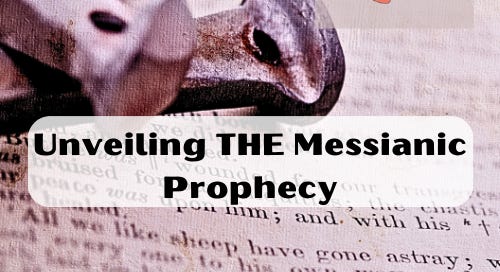Unveiling THE Messianic Prophecy
A Close Look at Isaiah 53 and the New Testament
In the compendium of biblical literature, one of the standout prophetic utterances resides in the 53rd chapter of the Book of Isaiah. This specific segment of scripture outlines the portrayal of the Suffering Servant—a figure acquainted with sorrows, bearing the repercussions of transgressions not His own. This chapter presents a clear prophetic delineation of the mission and life of Jesus Christ. Through an examination of New Testament scriptures, one can see where the accounts of Jesus’ life experiences align perfectly with the predictions contained in Isaiah 53.
Matthew 8:16-17 and Isaiah 53:4
In the Gospel according to Matthew, we observe an instance where Jesus took upon Himself the infirmities and bore the sicknesses of the people. Matthew directly correlates this healing ministry of Jesus to the words spoken by the prophet Isaiah, accentuating the restorative role Jesus played both physically and spiritually. Jesus’ acts of healing are seen as a manifestation of Isaiah’s prophecy, where the servant takes upon Himself the griefs and sorrows of humanity, bringing about a healing that transcends mere physical restoration, delving deep into the spiritual recesses of the human condition.
Luke 22:37 and Isaiah 53:12
The Gospel according to Luke presents a moment in the life of Jesus where He appropriates the words of Isaiah to Himself, identifying as the one “numbered with the transgressors.” In the ultimate act of self-sacrifice, Jesus foresees His death and the inevitable association with criminals. The crucifixion narrative in the New Testament vividly fulfills this prophecy, as Jesus is crucified between two criminals, epitomizing the servant who not only bears the iniquities of many but intercedes for the transgressors, as noted in Isaiah’s prophecy.
Acts 8:30-35 and Isaiah 53:7-8
In the book of Acts, Philip employs Isaiah 53 as a foundational text to elucidate the gospel message to the Ethiopian eunuch. The depicted servant in Isaiah, silent and unfairly treated, yet sacrificial, mirrors the characterization of Jesus during His trial and crucifixion. He did not verbally defend Himself but chose a path of sacrificial death for the redemption of humanity. The words of Isaiah find a clear echo in the narrative of Jesus, who embodied the essence of the willing and silent servant who gave up His life, fulfilling a divine mandate and securing salvation for humanity.
1 Peter 2:22-25 and Isaiah 53:5-6, 9
Peter, one of Jesus' closest disciples, crafts a message that leverages various facets of Isaiah 53 to depict Jesus as the fulfillment of the prophetic vision contained therein. Peter underscores Jesus’ sinless nature and His role as a healing figure, highlighting the servant's suffering as narrated by Isaiah, and the restorative power emanating from His sacrifices. Peter's detailed allusions to Isaiah 53, showcasing Jesus as the shepherd guiding individuals towards righteousness, further authenticate the messianic nature of Isaiah’s prophecy.
Conclusion
The 53rd chapter of the book of Isaiah offers a prophecy detailing a servant who endures immense suffering yet fulfills a redemptive purpose, a role we see vividly depicted in the life and mission of Jesus Christ as documented in the New Testament.
Throughout the New Testament, a common thread emerges: a deliberate echoing of Isaiah's prophetic insights, demonstrating an unbroken line connecting the ancient prophecy to Jesus Christ. From Matthew’s depiction of the healing ministry to Peter's reflections on the shepherd guiding individuals to righteousness, we witness a unison of voices affirming Jesus as the manifestation of the Suffering Servant Isaiah foretold.
In examining this prophecy through the lens of Christian doctrine, it not only substantiates the historical and prophetic alignment but elevates our understanding of Jesus’ mission, offering a deeper insight into God’s intricate plan of salvation—a story of hope, sacrifice, and ultimate redemption that finds its fulfillment in the life of Jesus Christ.
By bringing together these narratives, Isaiah 53 stands as a testament to a divinely orchestrated narrative, a prophetic vision carefully laid down in ancient scripture and realized fully in the person and mission of Jesus. It delineates a journey from prophecy to realization, encapsulating themes of suffering, redemption, and the promise of eternal life, thereby presenting a compelling case for recognizing Isaiah 53 as a central messianic prophecy in Christian theology.




Well done...